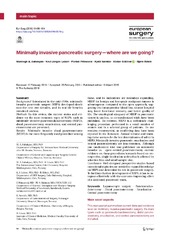| dc.description.abstract | Background Introduced in the mid-1990s, minimally invasive pancreatic surgery (MIPS) developed slowly over the next two decades, and its real-life benefits remained unclear. Methods In this review, the current status and evidence on the most common types of MIPS, such as minimally invasive pancreatoduodenectomy (MIPD), distal pancreatectomy, enucleation, and central pancreatectomy are presented. Results Minimally invasive distal pancreatectomy (MIDP) is the most frequently used procedure among these, and its indications are nowadays expanding. MIDP for benign and low-grade malignant tumors is advantageous compared to the open approach, suggesting less intraoperative blood loss, shorter hospital stay, faster functional recovery, and better quality of life. The oncological adequacy of MIDP in pancreatic cancer is unclear, as no randomized trials have been published. In contrast, MIPD is a technically challenging procedure performed in a small number of centers and in a selected group of patients. Its use remains controversial, as conflicting data have been reported in the literature. Annual volume and learning curve seem to be the key determinants of safety in MIPD. Minimally invasive pancreatic enucleation and central pancreatectomy are less common. Although one randomized trial was published on minimally invasive vs. open central pancreatectomy, current evidence on these procedures is mostly based on retrospective, single-institution series clearly affected by selection bias and small sample size. Conclusion Well-designed prospective studies based on national registries are needed to expand knowledge on MIPS and determine its role in pancreatic surgery. To facilitate further development of MIPS, it has to integrate effectively with the outcome-improving effect of a dedicated pancreatic team. | en_US |

